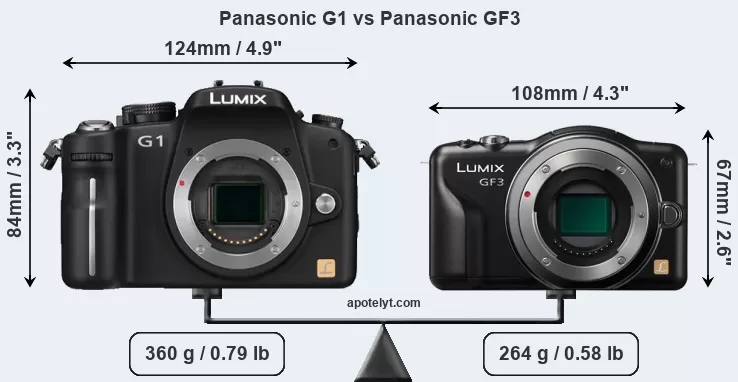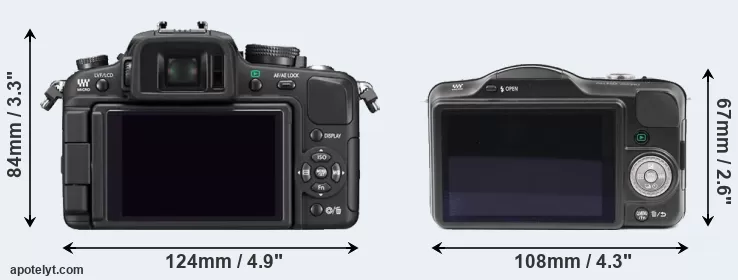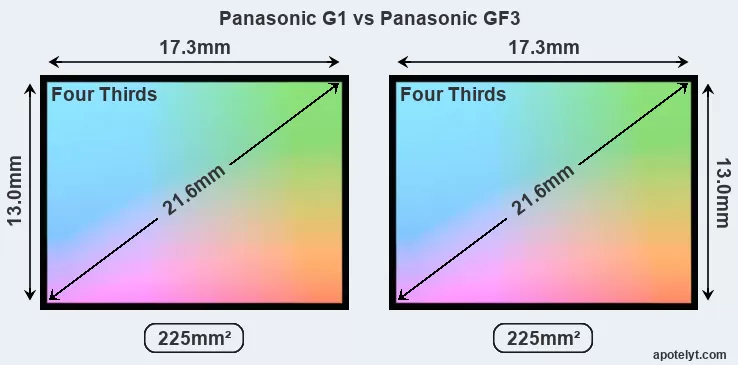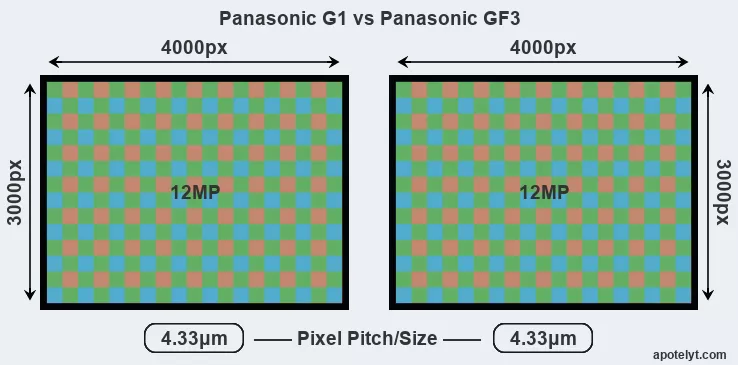Panasonic G1 vs GF3
The Panasonic Lumix DMC-G1 and the Panasonic Lumix DMC-GF3 are two digital cameras that were announced, respectively, in September 2008 and June 2011. Both the G1 and the GF3 are mirrorless interchangeable lens cameras that are equipped with a Four Thirds sensor. Both cameras offer a resolution of 12 megapixels.
Below is an overview of the main specs of the two cameras as a starting point for the comparison.

Check G1 offers at
ebay.com

Check GF3 offers at
ebay.com
Going beyond this snapshot of core features and characteristics, what are the differences between the Panasonic Lumix DMC-G1 and the Panasonic Lumix DMC-GF3? Which one should you buy? Read on to find out how these two cameras compare with respect to their body size, their imaging sensors, their shooting features, their input-output connections, and their reception by expert reviewers.
Body comparison
An illustration of the physical size and weight of the Panasonic G1 and the Panasonic GF3 is provided in the side-by-side display below. The two cameras are presented according to their relative size. Three consecutive perspectives from the front, the top, and the back are available. All size dimensions are rounded to the nearest millimeter.
The GF3 can be obtained in five different colors (black, brown, pink, red, white), while the G1 is only available in black.



If the front view area (width x height) of the cameras is taken as an aggregate measure of their size, the Panasonic GF3 is considerably smaller (31 percent) than the Panasonic G1. Moreover, the GF3 is markedly lighter (27 percent) than the G1. In this context, it is worth noting that neither the G1 nor the GF3 are weather-sealed.
The above size and weight comparisons are to some extent incomplete since they do not consider the interchangeable lenses that both of these cameras require. In this particular case, both cameras feature the same lens mount, so that they can use the same lenses. You can compare the optics available in the Micro Four Thirds Lens Catalog. Mirrorless cameras, such as the two under consideration, have the additional advantage of having a short flange to focal plane distance, which makes it possible to mount many lenses from other systems onto the camera via adapters.
Concerning battery life, the G1 gets 410 shots out of its Panasonic DMW-BLB13 battery, while the GF3 can take 300 images on a single charge of its Panasonic DMW-BLE9 power pack.
The following table provides a synthesis of the main physical specifications of the two cameras and other similar ones. If you would like to visualize and compare a different camera combination, you can navigate to the CAM-parator app and make your selection from a broad list of cameras there.

| # | Camera Model |
Camera Width |
Camera Height |
Camera Depth |
Camera Weight |
Battery Life |
Weather Sealing |
Camera Launch |
Launch Price (USD) |
Street Price |
|
|---|---|---|---|---|---|---|---|---|---|---|---|
| 1. | Panasonic G1 | 124 mm | 84 mm | 45 mm | 360 g | 410 | n | Sep 2008 | 599 | ebay.com | |
| 2. | Panasonic GF3 | 108 mm | 67 mm | 32 mm | 264 g | 300 | n | Jun 2011 | 549 | ebay.com | |
| 3. | Olympus E-410 | 130 mm | 91 mm | 53 mm | 435 g | 500 | n | Mar 2007 | 699 | ebay.com | |
| 4. | Panasonic GF6 | 111 mm | 65 mm | 38 mm | 323 g | 340 | n | Apr 2013 | 499 | ebay.com | |
| 5. | Panasonic GF5 | 108 mm | 67 mm | 37 mm | 267 g | 360 | n | Apr 2012 | 499 | ebay.com | |
| 6. | Panasonic G3 | 115 mm | 84 mm | 47 mm | 336 g | 270 | n | May 2011 | 599 | ebay.com | |
| 7. | Panasonic G10 | 124 mm | 84 mm | 74 mm | 388 g | 380 | n | Mar 2010 | 499 | ebay.com | |
| 8. | Panasonic G2 | 124 mm | 84 mm | 74 mm | 428 g | 360 | n | Mar 2010 | 599 | ebay.com | |
| 9. | Panasonic GF2 | 113 mm | 68 mm | 33 mm | 310 g | 300 | n | Nov 2010 | 549 | ebay.com | |
| 10. | Panasonic GF1 | 119 mm | 71 mm | 36 mm | 385 g | 380 | n | Sep 2009 | 749 | ebay.com | |
| 11. | Panasonic GH1 | 124 mm | 90 mm | 45 mm | 385 g | 300 | n | Mar 2009 | 899 | ebay.com | |
| 12. | Panasonic L10 | 135 mm | 96 mm | 78 mm | 556 g | 450 | n | Aug 2007 | 599 | ebay.com | |
| Note: Measurements and pricing do not include easily detachable parts, such as add-on or interchangeable lenses or optional viewfinders. | |||||||||||
The price is, of course, an important factor in any camera decision. The retail prices at the time of the camera’s release place the model in the market relative to other models in the producer’s line-up and the competition. The GF3 was somewhat cheaper (by 8 percent) than the G1 at launch, but both cameras fall into the same price category. Usually, retail prices stay at first close to the launch price, but after several months, discounts become available. Later in the product cycle and, in particular, when the replacement model is about to appear, further discounting and stock clearance sales often push the camera price considerably down. Then, after the new model is out, very good deals can frequently be found on the pre-owned market.
Sensor comparison
The imaging sensor is at the core of digital cameras and its size is one of the main determining factors of image quality. A large sensor will tend to have larger individual pixels that provide better low-light sensitivity, wider dynamic range, and richer color-depth than smaller pixel-units in a sensor of the same technological generation. Furthermore, a large sensor camera will give the photographer more possibilities to use shallow depth-of-field in order to isolate a subject from the background. On the downside, larger sensors are more costly to manufacture and tend to lead to bigger and heavier cameras and lenses.
Both cameras under consideration feature a Four Thirds sensor and have a format factor (sometimes also referred to as "crop factor") of 2.0. Within the spectrum of camera sensors, this places the review cameras among the medium-sized sensor cameras that aim to strike a balance between image quality and portability. Both cameras feature a native aspect ratio (sensor width to sensor height) of 4:3.

The two cameras under review do not only share the same sensor size, but also offer an identical resolution of 12 megapixels. This similarity in sensor specs implies that both the G1 and the GF3 have the same pixel density, as well as the same pixel size. It should, however, be noted that the GF3 is much more recent (by 2 years and 9 months) than the G1, and its sensor will have benefitted from technological advances during this time.
The Panasonic Lumix DMC-G1 has a native sensitivity range from ISO 100 to ISO 1600, which can be extended to ISO 100-3200. The corresponding ISO settings for the Panasonic Lumix DMC-GF3 are ISO 160 to ISO 6400 (no boost).
Technology-wise, both cameras are equipped with CMOS (Complementary Metal–Oxide–Semiconductor) sensors. Both cameras use a Bayer filter for capturing RGB colors on a square grid of photosensors. This arrangement is found in most digital cameras.

For many cameras, data on sensor performance has been reported by DXO Mark. This service determines an overall sensor rating, as well as sub-scores for low-light sensitivity ("DXO Sports"), dynamic range ("DXO Landscape"), and color depth ("DXO Portrait"). The Overall DXO ratings for the two cameras under consideration are close, suggesting that they provide similar imaging performance. The table below summarizes the physical sensor characteristics and sensor quality findings and compares them across a set of similar cameras.

| # | Camera Model |
Sensor Class |
Resolution (MP) |
Horiz. Pixels |
Vert. Pixels |
Video Format |
DXO Portrait |
DXO Landscape |
DXO Sports |
DXO Overall |
|
|---|---|---|---|---|---|---|---|---|---|---|---|
| 1. | Panasonic G1 | Four Thirds | 12.0 | 4000 | 3000 | none | 21.1 | 10.3 | 463 | 53 | |
| 2. | Panasonic GF3 | Four Thirds | 12.0 | 4000 | 3000 | 1080/60i | 20.6 | 10.1 | 459 | 50 | |
| 3. | Olympus E-410 | Four Thirds | 10.0 | 3648 | 2736 | none | 21.1 | 10.0 | 494 | 51 | |
| 4. | Panasonic GF6 | Four Thirds | 15.8 | 4592 | 3448 | 1080/60i | 20.7 | 10.6 | 622 | 54 | |
| 5. | Panasonic GF5 | Four Thirds | 12.0 | 4000 | 3000 | 1080/60i | 20.5 | 10.0 | 573 | 50 | |
| 6. | Panasonic G3 | Four Thirds | 15.8 | 4592 | 3448 | 1080/60i | 21.0 | 10.6 | 667 | 56 | |
| 7. | Panasonic G10 | Four Thirds | 12.0 | 4000 | 3000 | 720/30p | 21.2 | 10.1 | 411 | 52 | |
| 8. | Panasonic G2 | Four Thirds | 12.0 | 4000 | 3000 | 720/30p | 21.2 | 10.3 | 493 | 53 | |
| 9. | Panasonic GF2 | Four Thirds | 12.0 | 4000 | 3000 | 1080/60i | 21.2 | 10.3 | 506 | 54 | |
| 10. | Panasonic GF1 | Four Thirds | 12.0 | 4000 | 3000 | 720/30p | 21.2 | 10.3 | 513 | 54 | |
| 11. | Panasonic GH1 | Four Thirds | 12.0 | 4000 | 3000 | 1080/24p | 21.6 | 11.6 | 772 | 64 | |
| 12. | Panasonic L10 | Four Thirds | 10.0 | 3648 | 2736 | none | 21.3 | 10.8 | 429 | 55 |
Many modern cameras cannot only take still pictures, but also record videos. The GF3 indeed provides for movie recording, while the G1 does not. The highest resolution format that the GF3 can use is 1080/60i.
Feature comparison
Beyond body and sensor, cameras can and do differ across a range of features. For example, the G1 has an electronic viewfinder (1440k dots), which can be very helpful when shooting in bright sunlight. In contrast, the GF3 relies on live view and the rear LCD for framing. The table below summarizes some of the other core capabilities of the Panasonic G1 and Panasonic GF3 in connection with corresponding information for a sample of similar cameras.

| # | Camera Model |
Viewfinder (Type or 000 dots) |
Control Panel (yes/no) |
LCD Specifications (inch/000 dots) |
LCD Attach- ment |
Touch Screen (yes/no) |
Max Shutter Speed * |
Max Shutter Flaps * |
Built-in Flash (yes/no) |
Built-in Image Stab |
|
|---|---|---|---|---|---|---|---|---|---|---|---|
| 1. | Panasonic G1 | 1440 | n | 3.0 / 460 | swivel | n | 1/4000s | 3.0/s | Y | n | |
| 2. | Panasonic GF3 | none | n | 3.0 / 460 | fixed | Y | 1/4000s | 3.2/s | Y | n | |
| 3. | Olympus E-410 | optical | n | 2.5 / 215 | fixed | n | 1/4000s | 3.0/s | Y | n | |
| 4. | Panasonic GF6 | none | n | 3.0 / 1040 | tilting | Y | 1/4000s | 4.2/s | Y | n | |
| 5. | Panasonic GF5 | none | n | 3.0 / 920 | fixed | Y | 1/4000s | 4.0/s | Y | n | |
| 6. | Panasonic G3 | 1440 | n | 3.0 / 460 | swivel | Y | 1/4000s | 4.0/s | Y | n | |
| 7. | Panasonic G10 | 202 | n | 3.0 / 460 | fixed | n | 1/4000s | 2.6/s | Y | n | |
| 8. | Panasonic G2 | 1440 | n | 3.0 / 460 | swivel | Y | 1/4000s | 2.6/s | Y | n | |
| 9. | Panasonic GF2 | optional | n | 3.0 / 460 | fixed | Y | 1/4000s | 2.6/s | Y | n | |
| 10. | Panasonic GF1 | optional | n | 3.0 / 460 | fixed | n | 1/4000s | 3.0/s | Y | n | |
| 11. | Panasonic GH1 | 1440 | n | 3.0 / 460 | swivel | n | 1/4000s | 3.0/s | Y | n | |
| 12. | Panasonic L10 | optical | n | 2.5 / 207 | swivel | n | 1/4000s | 3.0/s | Y | n | |
| Note: *) Information refers to the mechanical shutter, unless the camera only has an electronic one. | |||||||||||
One differentiating feature between the two cameras concerns the touch sensitivity of the rear screen. The GF3 has a touchscreen, while the G1 has a conventional panel. Touch control can be particularly helpful, for example, for setting the focus point.
The G1 has an articulated LCD that can be turned to be front-facing. This characteristic will be appreciated by vloggers and photographers who are interested in snapping selfies. In contrast, the GF3 does not have a selfie-screen.The G1 writes its imaging data to SDHC cards, while the GF3 uses SDXC cards.
Connectivity comparison
For some imaging applications, the extent to which a camera can communicate with its environment can be an important aspect in the camera decision process. The table below provides an overview of the connectivity of the Panasonic Lumix DMC-G1 and Panasonic Lumix DMC-GF3 and, in particular, the interfaces the cameras (and selected comparators) provide for accessory control and data transfer.

| # | Camera Model |
Hotshoe Port |
Internal Mic / Speaker |
Microphone Port |
Headphone Port |
HDMI Port |
USB Port |
WiFi Support |
NFC Support |
Bluetooth Support |
|
|---|---|---|---|---|---|---|---|---|---|---|---|
| 1. | Panasonic G1 | Y | - / - | - | - | mini | 2.0 | - | - | - | |
| 2. | Panasonic GF3 | - | stereo / mono | - | - | mini | 2.0 | - | - | - | |
| 3. | Olympus E-410 | Y | - / - | - | - | - | 2.0 | - | - | - | |
| 4. | Panasonic GF6 | - | stereo / mono | - | - | mini | 2.0 | Y | Y | - | |
| 5. | Panasonic GF5 | - | stereo / mono | - | - | mini | 2.0 | - | - | - | |
| 6. | Panasonic G3 | Y | stereo / mono | - | - | mini | 2.0 | - | - | - | |
| 7. | Panasonic G10 | Y | mono / - | - | - | mini | 2.0 | - | - | - | |
| 8. | Panasonic G2 | Y | stereo / mono | - | - | mini | 2.0 | - | - | - | |
| 9. | Panasonic GF2 | Y | stereo / mono | - | - | mini | 2.0 | - | - | - | |
| 10. | Panasonic GF1 | Y | mono / mono | - | - | mini | 2.0 | - | - | - | |
| 11. | Panasonic GH1 | Y | stereo / - | Y | - | mini | 2.0 | - | - | - | |
| 12. | Panasonic L10 | Y | - / - | - | - | - | 2.0 | - | - | - |
It is notable that the G1 has a hotshoe, while the GF3 does not. This socket makes it possible to easily attach optional accessories, such as an external flash gun.
Both the G1 and the GF3 have been discontinued, but can regularly be found used on ebay. The G1 was replaced by the Panasonic G2, while the GF3 was followed by the Panasonic GF5. Further information on the features and operation of the G1 and GF3 can be found, respectively, in the Panasonic G1 Manual (free pdf) or the online Panasonic GF3 Manual.
Review summary
So how do things add up? Is the Panasonic G1 better than the Panasonic GF3 or vice versa? Below is a summary of the relative strengths of each of the two contestants.
Advantages of the Panasonic Lumix DMC-G1:
- Easier framing: Has an electronic viewfinder for image composition and settings control.
- More flexible LCD: Has a swivel screen for odd-angle shots in portrait or landscape orientation.
- More selfie-friendly: Has an articulated screen that can be turned to be front-facing.
- Longer lasting: Can take more shots (410 versus 300) on a single battery charge.
- Better lighting: Features a hotshoe and can thus hold and trigger an external flash gun.
- More heavily discounted: Has been available for much longer (launched in September 2008).
Reasons to prefer the Panasonic Lumix DMC-GF3:
- Broader imaging potential: Can capture not only stills but also 1080/60i video.
- Fewer buttons to press: Has a touchscreen to facilitate handling and shooting adjustments.
- More compact: Is smaller (108x67mm vs 124x84mm) and will fit more readily into a bag.
- Less heavy: Has a lower weight (by 96g or 27 percent) and is thus easier to take along.
- More modern: Reflects 2 years and 9 months of technical progress since the G1 launch.
If the count of relative strengths (bullet points above) is taken as a measure, the G1 comes out slightly ahead of the GF3 (6 : 5 points). However, the pertinence of the various camera strengths will differ across photographers, so that you might want to weigh individual camera traits according to their importance for your own imaging needs before making a camera decision. A professional wildlife photographer will view the differences between cameras in a way that diverges from the perspective of a family photog, and a person interested in architecture has distinct needs from a sports shooter. Hence, the decision which camera is best and worth buying is often a very personal one.
How about other alternatives? Do the specifications of the Panasonic G1 and the Panasonic GF3 place the cameras among the top in their class? Find out in the latest Best Mirrorless Interchangeable Lens Camera listing whether the two cameras rank among the cream of the crop.
In any case, while the comparison of the spec-sheets of cameras can offer a general idea of their imaging potential, it remains partial and cannot reveal, for example, the shooting experience and imaging performance when actually working with the G1 or the GF3. User reviews that are available, for instance, at amazon can sometimes shed light on these issues, but such feedback is all too often partial, inconsistent, and inaccurate.
Expert reviews
This is why expert reviews are important. The adjacent summary-table relays the overall verdicts of several of the most popular camera review sites (amateurphotographer [AP], cameralabs [CL], digitalcameraworld [DCW], dpreview [DPR], ephotozine [EPZ], photographyblog [PB]). As can be seen, the professional reviewers agree in many cases on the quality of different cameras, but sometimes their assessments diverge, reinforcing the earlier point that a camera decision is often a very personal choice.

| # | Camera Model |
AP score |
CL score |
DCW score |
DPR score |
EPZ score |
PB score |
Camera Launch |
Launch Price (USD) |
Street Price |
|
|---|---|---|---|---|---|---|---|---|---|---|---|
| 1. | Panasonic G1 | .. | + + | .. | 70/100 | 4/5 | 4.5/5 | Sep 2008 | 599 | ebay.com | |
| 2. | Panasonic GF3 | 3/5 | 82/100 | .. | 71/100 | 4.5/5 | 4/5 | Jun 2011 | 549 | ebay.com | |
| 3. | Olympus E-410 | .. | 86/100 | .. | + + | 4/5 | 4.5/5 | Mar 2007 | 699 | ebay.com | |
| 4. | Panasonic GF6 | .. | + + | .. | .. | 4.5/5 | 4.5/5 | Apr 2013 | 499 | ebay.com | |
| 5. | Panasonic GF5 | 3/5 | .. | .. | .. | 4.5/5 | 4.5/5 | Apr 2012 | 499 | ebay.com | |
| 6. | Panasonic G3 | 3/5 | + + | .. | 75/100 | 4.5/5 | 5/5 | May 2011 | 599 | ebay.com | |
| 7. | Panasonic G10 | 3/5 | .. | .. | 70/100 | 4/5 | 4/5 | Mar 2010 | 499 | ebay.com | |
| 8. | Panasonic G2 | .. | .. | .. | 72/100 | 4/5 | 4.5/5 | Mar 2010 | 599 | ebay.com | |
| 9. | Panasonic GF2 | 3/5 | 82/100 | .. | 70/100 | 4.5/5 | 4.5/5 | Nov 2010 | 549 | ebay.com | |
| 10. | Panasonic GF1 | .. | 85/100 | .. | 69/100 | 4.5/5 | 4.5/5 | Sep 2009 | 749 | ebay.com | |
| 11. | Panasonic GH1 | .. | + + | .. | 72/100 | 4.5/5 | 4.5/5 | Mar 2009 | 899 | ebay.com | |
| 12. | Panasonic L10 | .. | 85/100 | .. | + | 3.5/5 | 4/5 | Aug 2007 | 599 | ebay.com | |
| Note: (+ +) highly recommended; (+) recommended; (o) reviewed; (..) not available. | |||||||||||
Care should be taken when interpreting the review scores above, though. The ratings are only valid when referring to cameras in the same category and of the same age. Thus, a score needs to be put into the context of the launch date and the launch price of the camera, and comparisons of ratings among very different cameras or across long time periods have little meaning. Also, please note that some of the review sites have changed their methodology and reporting over time.

Check G1 offers at
ebay.com

Check GF3 offers at
ebay.com
Other camera comparisons
Did this review help to inform your camera decision process? In case you would like to check on the differences and similarities of other camera models, just make your choice using the following search menu. Alternatively, you can follow any of the listed hyperlinks for comparisons that others found interesting.
- Canon 100D vs Panasonic GF3
- Canon 5DS R vs Panasonic GF3
- Canon T3 vs Panasonic GF3
- Canon T7 vs Panasonic G1
- Epson R-D1 vs Panasonic GF3
- Leica X2 vs Panasonic G1
- Panasonic FZ2000 vs Panasonic G1
- Panasonic G1 vs Panasonic GF1
- Panasonic G1 vs Pentax 645D
- Panasonic G1 vs Sony HX99
- Panasonic GF3 vs Panasonic GF5
- Panasonic GF3 vs Panasonic GF7
Specifications: Panasonic G1 vs Panasonic GF3
Below is a side-by-side comparison of the specs of the two cameras to facilitate a quick review of their differences and common features.
| Camera Model | Panasonic G1 | Panasonic GF3 |
|---|---|---|
| Camera Type | Mirrorless system camera | Mirrorless system camera |
| Camera Lens | Micro Four Thirds lenses | Micro Four Thirds lenses |
| Launch Date | September 2008 | June 2011 |
| Launch Price | USD 599 | USD 549 |
| Sensor Specs | Panasonic G1 | Panasonic GF3 |
| Sensor Technology | CMOS | CMOS |
| Sensor Format | Four Thirds Sensor | Four Thirds Sensor |
| Sensor Size | 17.3 x 13.0 mm | 17.3 x 13.0 mm |
| Sensor Area | 224.9 mm2 | 224.9 mm2 |
| Sensor Diagonal | 21.6 mm | 21.6 mm |
| Crop Factor | 2.0x | 2.0x |
| Sensor Resolution | 12 Megapixels | 12 Megapixels |
| Image Resolution | 4000 x 3000 pixels | 4000 x 3000 pixels |
| Pixel Pitch | 4.33 μm | 4.33 μm |
| Pixel Density | 5.34 MP/cm2 | 5.34 MP/cm2 |
| Moiré control | Anti-Alias filter | Anti-Alias filter |
| Movie Capability | no Video | 1080/60i Video |
| ISO Setting | 100 - 1,600 ISO | 160 - 6,400 ISO |
| ISO Boost | 100 - 3,200 ISO | no Enhancement |
| Image Processor | Venus HD | Venus FHD |
| DXO Sensor Quality (score) | 53 | 50 |
| DXO Color Depth (bits) | 21.1 | 20.6 |
| DXO Dynamic Range (EV) | 10.3 | 10.1 |
| DXO Low Light (ISO) | 463 | 459 |
| Screen Specs | Panasonic G1 | Panasonic GF3 |
| Viewfinder Type | Electronic viewfinder | no viewfinder |
| Viewfinder Field of View | 100% | |
| Viewfinder Magnification | 0.70x | |
| Viewfinder Resolution | 1440k dots | |
| LCD Framing | Live View | Live View |
| Rear LCD Size | 3.0inch | 3.0inch |
| LCD Resolution | 460k dots | 460k dots |
| LCD Attachment | Swivel screen | Fixed screen |
| Touch Input | no Touchscreen | Touchscreen |
| Shooting Specs | Panasonic G1 | Panasonic GF3 |
| Focus System | Contrast-detect AF | Contrast-detect AF |
| Continuous Shooting | 3 shutter flaps/s | 3.2 shutter flaps/s |
| Fill Flash | Built-in Flash | Built-in Flash |
| Storage Medium | SDHC cards | SDXC cards |
| Single or Dual Card Slots | Single card slot | Single card slot |
| UHS card support | no | no |
| Connectivity Specs | Panasonic G1 | Panasonic GF3 |
| External Flash | Hotshoe | no Hotshoe |
| USB Connector | USB 2.0 | USB 2.0 |
| HDMI Port | mini HDMI | mini HDMI |
| Wifi Support | no Wifi | no Wifi |
| Body Specs | Panasonic G1 | Panasonic GF3 |
| Battery Type | Panasonic DMW-BLB13 | Panasonic DMW-BLE9 |
| Battery Life (CIPA) | 410 shots per charge | 300 shots per charge |
| Body Dimensions |
124 x 84 x 45 mm (4.9 x 3.3 x 1.8 in) |
108 x 67 x 32 mm (4.3 x 2.6 x 1.3 in) |
| Camera Weight | 360 g (12.7 oz) | 264 g (9.3 oz) |

Check G1 offers at
ebay.com

Check GF3 offers at
ebay.com
Did you notice an error on this page? If so, please get in touch, so that we can correct the information.

